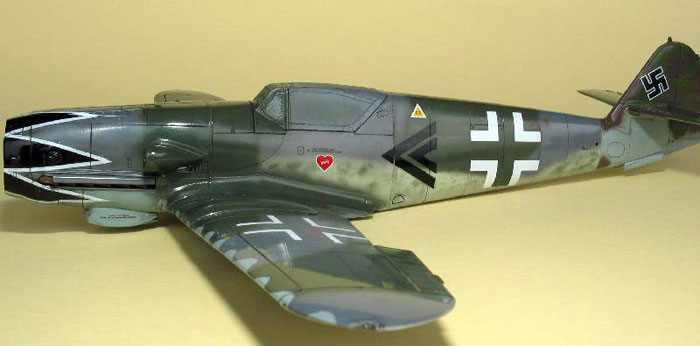|
Late-War RLM
76
By
Michael Ullmann

The late war appearance of Luftwaffe
colour RLM 76 is a hot topic for discussion. There are many opinions about this
subject. A few touch reality, while some are nothing short of science fiction!
Before I start, it is
essential to outline some basic information for a common
understanding.
Aviation Lacquers for
Metal Surfaces - the Basics
First we will discuss
Aviation lacquers for all-metal aircraft.
The RLM attempted to find a
single coat paint for painting their all-metal aircraft. This means
that a single coat covers the aircraft surface, with no need for a
primer.
We are not discussing fabric over wood - that topic is for another
day.
Aviation lacquer 7122 was developed for metal surfaces. This lacquer
was available in all camouflage shades. The thinner 7200.00 was
explicitly specified for this lacquer. No other thinner was allowed,
because other thinning agents would destroy the special capabilities
of the lacquer. In particular, fuel was forbidden to be used as a
thinner as it would degrade the pigmentation of the paint.
The latest RLM documents in my possession dealing with Luftwaffe
aircraft camouflage are dated January 1945. These document always
specify RLM 76. The documents are also too late to offer an
explanation for the appearance of the greenish variation of RLM 76
noted in colour photos from 1944. I am sure that every one will
agree with me that, in these final months of the war, the collapsing
Luftwaffe was unable to introduce a new bright camouflage colour and
start a massive substitution programme. Therefore, no evidence
exists for an official “new” bright camouflage colour.
Early in the war the German lacquer industry was able to create
lacquers that contained 30% or 40% of pigment. This meant that
Aviation Lacquer 7122 delivered excellent coverage over the metal
skin of aircraft even for light, bright colours such as RLM 65 or
76.
Later in the war the
percentage of the pigments was decreased in an attempt to save raw
materials.
The best surface protection for aluminium is still zinc chromate. I
was very surprised when I learnt that German Aviation lacquer also
contains zinc chromate.
Early in the war, bright
coloured Aviation lacquers did not contain zinc chromate for
effective surface protection of aluminium. However, later in the
war, the German lacquer industry could produce bright coloured
Aviation lacquers that also contained zinc chromate.
Zinc chromate is well known
for its yellow colour. Even so, the high percentage of pigment in
German lacquers effectively overpowered the colour of the yellow
zinc chromate.
The Explanation
Later in the war the
percentage of pigments was decreased, as mentioned above. Now the
brighter pigments were no longer able to cover the yellow zinc
chromate. The colour of the lacquer in the colour RLM 76 turned from
bright blue grey into a bright green grey.
This is the reason why you
find so many late war colour photos with that greenish colour.
Because the German lacquer industry produced the new formula in
massive amounts - mostly for fighter production - this caused the
widespread use of the greenish RLM 76 in the final months of the
war.
For Modellers
I used these assumptions for
the painting of my models.
Included in this article you
will see two photos of my interpretation Erich Hartmann's
Messerschmitt Bf 109K-4*, used in combat during the final days of
WWII over the Czech town Brno. No photographic evidence exists of
this aircraft, therefore my model is a kind of “What if”.
I mixed XtraColor RLM 76 with a yellow paint. I mix 1 part RLM 76
and 1 part XtraColor “X613 East German MiG 29 tan” to achieve the
greenish colour.
You can see that my Bf 109K-4 had the typical “German late-war
patchwork” appearance.

My model is finished in day
fighter camouflage colours 75/83/76 and unpainted undersides. I
painted the fuselage with my colour mix RLM 76. You can see the
different in colour of the tail. This part was made from wood and
fabric, and was manufactured by sub-contractors using a completely
different multicoat RLM-aviation lacquer. This resulted in a
different shade of RLM 76 compared to the rest of the airframe.
However, the multicoat RLM-aviation lacquer is not the topic of this
article.
For painting your late war Luftwaffe aircraft you can use your own
mix of RLM 76. You can also use RAF “Sky type S” as a substitute. No
one in the world is today able to give you an exact match of RLM 76
(or the other colours either) because of the multiple tones of the
different colours available from the different lacquer
manufacturers.
All the well known factors
including shortage of raw materials, improper use of the aviation
lacquer, using unsuitable thinners like fuel (as described recently
elsewhere on HyperScale, fuel was not a suitable thinner, the
pigments were not fuel resistant and therefore the colour of the
zinc chromate emerged), the use of substitutes and replacements for
raw material and not talking about the influence of the several
paint manufacturers in Germany giving a part of the solution. But
the explanation was still undiscovered.
I hope that my dissertation is not too “technical”. The model seemed
to offer the best opportunity to demonstrate the reality. My special
thanks goes to Jürgen Kiroff for sharing his information with me.
* some
sources suggest that this aircraft may have been a Bf 109G-10, Erla
production - ed.
Text & Images Copyright ©
2004 by Michael Ullmann
Page Created 15 December, 2004
Last Updated 15 December, 2004
Back to Reference Library
|
Home |
What's New |
Features |
Gallery |
Reviews |
Reference |
Forum |
Search